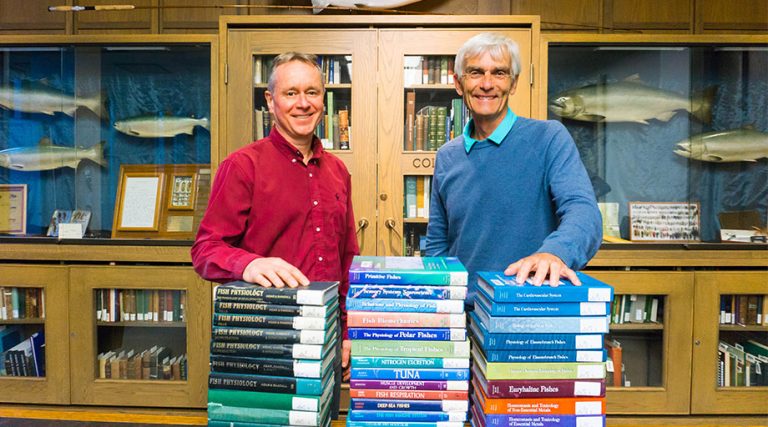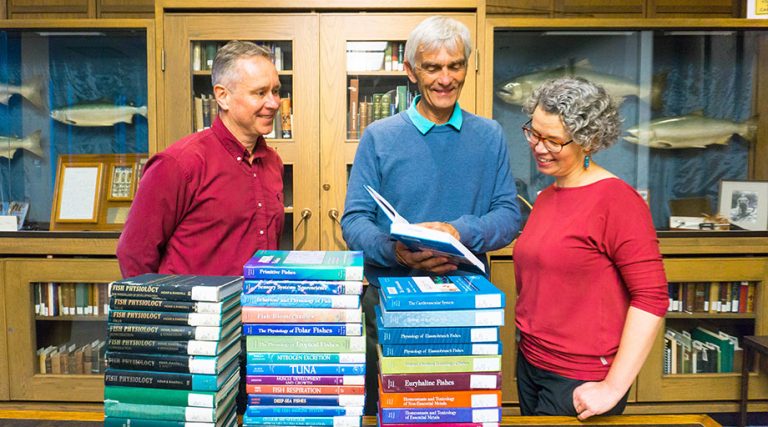
Fish Physiology series co-editors Drs. Colin Brauner and Anthony Farrell.
When Fish Physiology was founded in 1969 by UBC Zoology faculty members Drs. William S. Hoar and David J. Randall, there was no intention of continuing the series beyond six volumes. 50 years and 37 titled volumes later, the peer-reviewed monographic series is regarded as the leader in the field of fish physiology and a must-read for anyone interested in this domain, from senior undergraduate researchers through to mainstream university, government and industry employees.
The series is a frequently used resource at UBC Library and continues to be shepherded by UBC faculty members, Drs. Anthony Farrell and Colin Brauner, who were both graduate students of David Randall and have carried the successful series forward as co-editors, with Farrell joining in 1992 and Brauner in 2004.
A unique approach to integration and synthesis
Fish Physiology is unique in that its individual volumes have little in common except for publisher imposed length and general structure, with each volume representing the views of individual specialists on a particular subject. This thematic approach was taken very deliberately, explains Dr. Farrell, “We look at developments in the field and ask ‘What do we need to tell our colleagues?’. Over time, the series has morphed from being an encyclopedic resource about fish to a more applied and functional one, delving into interactions with the environment.” Among the subjects that have been discussed in Fish Physiology: Biology of Stress in Fish, Hypoxia (Oxygen deficiency), Organic Chemical Toxicology of Fishes and in the most recent volume, the effects of Carbon Dioxide.
Once a topic is established, the series editors bring on guest editors who are widely acknowledged as world leaders in their respective areas of expertise, enabling each volume to bring together intellectual contributions from the very best authors for the selected topic. “Beyond quality control, what Colin and I are most focused on is integration and synthesis” says Dr. Farrell, “What we try and do in a volume is say ‘Here is the big picture on this topic, here’s the supporting data from the thesis we are presenting and if you want to dig any deeper, here are the references… thereby allowing readers to move on to that next level of information gathering.’”

Fish Physiology series co-editors Drs. Colin Brauner and Anthony Farrell with Science Librarian Sally Taylor.
A leading resource in the field
“The series is available in print and online, and is a heavily-used and cited resource,” says Sally Taylor, Science Librarian at Woodward Library. “There are more than 200 chapter downloads per year from the UBC community alone.” Articles in Fish Physiology are often cited more than primary publications, making it the primary medium that authors in the field aspire to publish in. “The series has come to have such a legacy and prestige that we are finding that people are very excited to be asked to serve as guest editors or contributors,” says Dr. Brauner.
In 2020, Dr. Farrell plans to retire and a new series co-editor will join Dr. Brauner, UBC alumnus Dr. Erika Eliason, Assistant Professor of Ecology, Evolution, and Marine Biology at the University of California, Santa Barbara, who is highly respected in her field. Dr. Eliason is the first female editor for the series in its 50-year history.
Farrell and Brauner are optimistic about the future of the publication beyond their tenure. Says Brauner, “We know we have found the right person for the task.”
Access Fish Physiology in UBC Library’s collections.
This project is part of UBC Library’s strategic direction to create and deliver responsive collections.
Learn more about our Strategic Framework.
